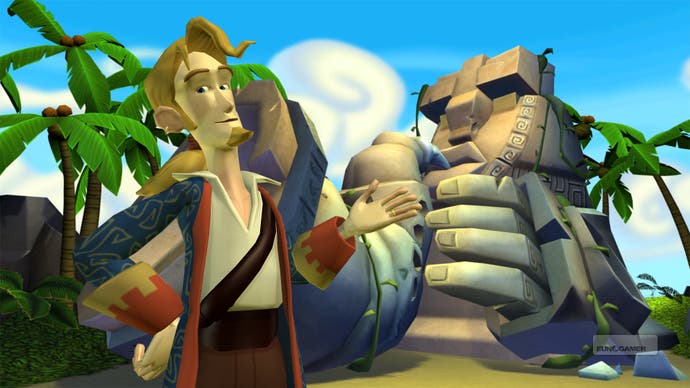Tales of Monkey Island: Launch of the Screaming Narwhal
Tales of the expected.
The return of the Monkey Island series after a nine-year absence has provoked almost as much hand-wringing worry as it has celebration. With so much love for LucasArts' long-dormant series among adventure enthusiasts, the pressure for Telltale Games to get it right is, to say the least, intense.
Announced just one month ago, Launch of the Screaming Narwhal is the first of five episodes scheduled for the season, and launches this week, just ahead of next week's Xbox Live Arcade remake of the seminal 1990 classic, The Secret of Monkey Island. Four further episodes are scheduled to follow at monthly intervals.
Chapter 1 finds the 'mighty pirate' Guybrush Threepwood in familiar territory - onboard a pirate ship, trying to save his wife Elaine from the clutches of nefarious zombie pirate LeChuck. After a simple rescue attempt goes awry, Guybrush finds himself in an even bigger jam. Trapped on the interminably windy Flotsam Island, he and therefore you are tasked with not only finding a ship to make your escape, but with putting a stop to the powerful gusts buffeting the place.
Designed by LucasArts veteran Dave Grossman, it's no surprise at all to find that Tales of Monkey Island slips straight back into the old routine. With Michael Land's nostalgic score setting the tone majestically, and Dominic Armato returning as Guybrush, it doesn't take long for that old Monkey Island magic to flood back. With a familiar array of snappy one-liners, throwaway puns, ludicrous characters and daft puzzles that stay true to the formula, all the ingredients are there for another feel-good adventure.
But things don't quite get off to the flying start that you might wish for. The first element to get to grips with is a control system best described as "interesting". Rather than adopt the simple, traditional point-and-click interface of old, Tales of Monkey Island insists that you move Guybrush around by holding down the mouse button and dragging in the desired direction. It takes some getting used to, but fortunately Telltale also allows for direct movement control via the cursor keys or WASD if you prefer. I did.

In addition, the introductory section also suffers a little because of a lurching camera, caused by the swell of the ocean waves. With the entire playing area bobbing around rhythmically, it makes the routine process of finding hotspots rather more troubling than it ought to be, and in tandem with the quirky new control system it feels like Telltale almost set out to make you feel seasick. Fortunately once you reach dry land, normal service resumes, but it's nevertheless not the most seamless way to resume the series.
As you might hope, the gameplay hasn't really changed one bit, and Telltale has clearly focused on nailing the fundamentals. It's still a straightforward mixture of dialogue-tree japery and bizarre inventory-manipulation, and follows the adventure game lineage faithfully. With the inventory tucked away on the right-hand side, the screen is free of icons and clutter, so whenever you want to dive into your infinite pockets, you have three basic options. Firstly, the magnifying glass lets you examine objects more closely, while two separate inventory slots allow you to slot in each object and perform the good old adventure game ritual of attempting to combine them. In addition, you're also able to take items out of the inventory and, say, give them to another character, or try and use them on something in the game world.
One of the most important elements in any adventure game is the quality of the puzzle design, and this is one area Tales of Monkey Island gets bang-on time after time. In true Monkey Island fashion, the solutions are mostly absurd, but also bizarrely logical in their own sweet way. On at least a handful of occasions, there is as much comedy to be found in finding a crackpot solution to the problem at hand as the story and dialogue itself.



